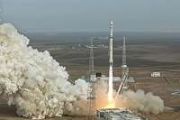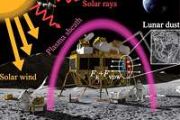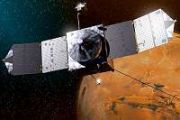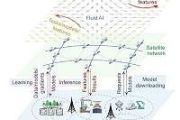
Copernical Team
Mapping the Sun's Interaction with Mercury's Surface
 A new study maps the infall of protons and electrons from the solar wind to geographical location on the surface of Mercury, giving scientists new insight into how interactions with the Sun alters the surface and produces Mercury's very thin atmosphere.
"Studies that have examined the infall of protons and electrons from the solar wind typically map the infall to the surface in terms of ti
A new study maps the infall of protons and electrons from the solar wind to geographical location on the surface of Mercury, giving scientists new insight into how interactions with the Sun alters the surface and produces Mercury's very thin atmosphere.
"Studies that have examined the infall of protons and electrons from the solar wind typically map the infall to the surface in terms of ti The young age of permanently shadowed areas on the Moon
 Most of the Moon's permanently shadowed areas arose less than 2.2 billion years ago and some trapped ice during the recent past, research led by Planetary Science Institute Senior Scientist Norbert Schorghofer shows.
"These findings change the prediction for where we would expect to find water ice on the Moon, and it dramatically changes estimates for how much water ice there is on the Moo
Most of the Moon's permanently shadowed areas arose less than 2.2 billion years ago and some trapped ice during the recent past, research led by Planetary Science Institute Senior Scientist Norbert Schorghofer shows.
"These findings change the prediction for where we would expect to find water ice on the Moon, and it dramatically changes estimates for how much water ice there is on the Moo CPI Vertex to provide KA-band antennas for SES'S O3B mPOWER
 CPI Vertex Antennentechnik, a subsidiary of Communications and Power Industries (CPI), has been selected to provide high-performance Ka-band antenna systems to SES for its O3b mPOWER communications system. These ground-based 5.5 meter Ka-band "plug and play" series tracking antennas will be used for O3b mPOWER Gateway systems.
The O3b mPOWER system is SES's second-generation medium Earth o
CPI Vertex Antennentechnik, a subsidiary of Communications and Power Industries (CPI), has been selected to provide high-performance Ka-band antenna systems to SES for its O3b mPOWER communications system. These ground-based 5.5 meter Ka-band "plug and play" series tracking antennas will be used for O3b mPOWER Gateway systems.
The O3b mPOWER system is SES's second-generation medium Earth o NASA contract Firefly to provide radio frequency calibration services from lunar orbit
 Firefly Aerospace, Inc., an end-to-end space transportation company, was awarded an $18 million NASA Commercial Lunar Payload Services (CLPS) contract to provide radio frequency calibration services from lunar orbit as part of Blue Ghost Mission 2, Firefly's second mission to the Moon in 2026. This contract marks Firefly's third NASA CLPS task order award, totaling nearly $230 million to date fo
Firefly Aerospace, Inc., an end-to-end space transportation company, was awarded an $18 million NASA Commercial Lunar Payload Services (CLPS) contract to provide radio frequency calibration services from lunar orbit as part of Blue Ghost Mission 2, Firefly's second mission to the Moon in 2026. This contract marks Firefly's third NASA CLPS task order award, totaling nearly $230 million to date fo Saturn images show a change of seasons as polar vortex fades
 While the UK has been experiencing warm autumnal weather, a team of planetary scientists has found that Saturn's late northern summer is experiencing a cooling trend, as huge planetary-scale flows of air have reversed direction as autumn approaches.
The new observations have also provided a last glimpse of Saturn's north pole, with its enormous warm vortex filled with hydrocarbon gases, be
While the UK has been experiencing warm autumnal weather, a team of planetary scientists has found that Saturn's late northern summer is experiencing a cooling trend, as huge planetary-scale flows of air have reversed direction as autumn approaches.
The new observations have also provided a last glimpse of Saturn's north pole, with its enormous warm vortex filled with hydrocarbon gases, be Electrons from Earth may be forming water on the Moon
 A team of researchers, led by a University of Hawai'i (UH) at Manoa planetary scientist, discovered that high energy electrons in Earth's plasma sheet are contributing to weathering processes on the Moon's surface and, importantly, the electrons may have aided the formation of water on the lunar surface. The study was published in Nature Astronomy.
Understanding the concentrations and dist
A team of researchers, led by a University of Hawai'i (UH) at Manoa planetary scientist, discovered that high energy electrons in Earth's plasma sheet are contributing to weathering processes on the Moon's surface and, importantly, the electrons may have aided the formation of water on the lunar surface. The study was published in Nature Astronomy.
Understanding the concentrations and dist SpaceTeamEurope, all united to launch Ariane 6
 Video:
00:09:37
Video:
00:09:37
The successful last Ariane 6 launch system combined tests HFT-3, at the German Aerospace Center in Lampoldshausen; and CTLO1-C, at Europe’s Spaceport in French Guiana, show the strength of European industrial and institutional collaboration. The “Space Team Europe” gets one step closer to the Ariane 6 first flight.
Eutelsat and NationalChip deliver ground-breaking Sat.tv features on Popular Set-Top Box Chipset
 Eutelsat Communications (Euronext Paris: ETL) and silicon chip maker NationalChip are bringing an enhanced Free-To-Air satellite TV viewing experience to millions of homes around the world, thanks to the integration of the Sat.tv services in a chipset that is widely used in set-top boxes around the world.
Over 1000 Free-to-Air TV channels broadcast by Eutelsat are viewed by 120 million hom
Eutelsat Communications (Euronext Paris: ETL) and silicon chip maker NationalChip are bringing an enhanced Free-To-Air satellite TV viewing experience to millions of homes around the world, thanks to the integration of the Sat.tv services in a chipset that is widely used in set-top boxes around the world.
Over 1000 Free-to-Air TV channels broadcast by Eutelsat are viewed by 120 million hom China builds new radio telescope to support lunar, deep-space missions
Intelsat delivers new reliable broadcast connectivity service
 Intelsat, operator of one of the world's largest integrated satellite and terrestrial networks and leading provider of inflight connectivity (IFC), today announced a new content distribution system that will use the internet to transport quality video content around the globe.
The IntelsatOne IP service capitalizes on Intelsat's decades of satellite and terrestrial experience to deliver re
Intelsat, operator of one of the world's largest integrated satellite and terrestrial networks and leading provider of inflight connectivity (IFC), today announced a new content distribution system that will use the internet to transport quality video content around the globe.
The IntelsatOne IP service capitalizes on Intelsat's decades of satellite and terrestrial experience to deliver re 































